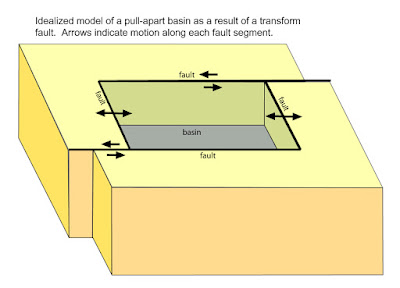The Dead Sea is a beautiful phenomenon that is located between Israel and Jordan. It is a pull-apart basin that was created by the Dead Sea Transform (DST). The Jordan River is one of its main source of water, and the Dead Sea has no outlet. The Dead Sea is about 422 meters below sea level, which makes it one of the lowest points on Earth. It is relatively a dry arid region because it is located on the Leeward side of the Judean Mountains causing it to be affected by the rain shadow effect. The Dead Sea is also one of the most hypersaline lakes on Earth, so there is no life present in this lake.
Current Conditions of the Dead Sea
The Dead Sea is constantly sinking due to the DST movement because it is estimated to be moving 5-7 mm per year (1). As well, the Dead Sea has dried up quite a bit over the past decades, especially in the southern parts. The Dead Sea's surface water is "dropping more than a meter each year" (2). As well, humans have a large impact on the decreasing water levels through the increased use of evaporation basins and irrigation. They have also contributed to global warming, which also has a major effect on the Dead Sea.
 |
| This picture shows how the Dead Sea has changed over the years and where the evaporation basins are located Picture from http://www.bbc.com/news/world-middle-east-36477284 |
 |
| This graphic shows how much and where the Dead Sea has lost its water over the time period of 1960-2007. Source: https://en.wikipedia.org/wiki/Dead_Sea |
 |
| Evidence of the Dead Sea's decreasing water levels Picture from: http://e360.yale.edu/feature/the_dead_sea_is_dying_can__a_controversial_plan_save_it/2551/ |
The Dead Sea 10,000 Years from Now
In 10,000 years from now, I think the Dead Sea will be fully dried up with no water left in the basin. This physical change can be attributed to climate change as the planet is warming. Global warming can cause areas all around to planet to have an increase in warmer temperatures. Thus, the Dead Sea already has a warm, dry climate and global warming can increase the intensity of warmer temperatures. This increase of warmer temperatures will increase the rate of evaporation from the Dead Sea, which will cause it to dry up faster. In other words, the rate of evaporation in the Dead Sea will be higher than the amount of water coming into the basin. Overall, all that would be left in the Dead Sea is salt deposits.
The Dead Sea 1,000,000 and 10,000,000 Years from Now
1,000,000 and 10,000,000 years from now, the Dead Sea will contain nothing and it would be left as a giant sinkhole. All of the salt deposits probably would have been collected by humans for their personal use. As well, since there would be no water left in the lake and the DST continues to move, it will cause the Dead Sea to sink at a faster rate. Therefore, the Dead Sea will be nothing but a giant sinkhole in between Israel and Jordan.
 |
| There have already been sinkholes around the Dead Sea Picture from http://www.bbc.com/news/world-middle-east-36477284 |
Overall the Dead Sea is shrinking and sinking at a constant rate every year. Even today, it has reached lower levels. The future of the Dead Sea is in the palms of our hands in terms of our contributions to climate change, the use of evaporation basins, and increase use of irrigation.
Sources:
1. Extreme Science. (n.d). Lowest Elevation: Dead Sea. Retrieved from http://www.extremescience.com/dead-sea.htm
2. Connolly, K. (2016). Dead sea drying: A new low point for Earth. Retrieved fromhttp://www.bbc.com/news/world-middle-east-36477284
1. Extreme Science. (n.d). Lowest Elevation: Dead Sea. Retrieved from http://www.extremescience.com/dead-sea.htm
2. Connolly, K. (2016). Dead sea drying: A new low point for Earth. Retrieved fromhttp://www.bbc.com/news/world-middle-east-36477284






